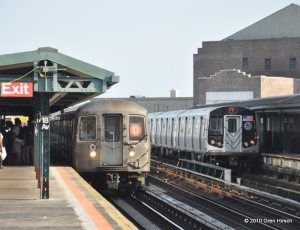 1992 Tube Stock 91155
1992 Tube Stock 91155
Location: White City Station, London, England
Operator of Vehicle: Transport for London
Date of Photo: May 19, 2008
For reasons I’ll share in a separate post, my 4 year old has taken an interest in the London Underground lately. As a result, the photo of the month is coming to us from London. I find photography on the Tube to be a mixed experience. The most positive aspect of it is that the staff are well trained on what the photography rules are and often come up to photographers to remind them that flash is not to be used instead of declaring (falsely in most circumstances) that photography on a subway system is illegal. The more challenging part of photographing on the Tube is that many of the angles and perspectives I usually try capturing are “flipped” on account of the system’s left hand running. You might now be thinking how big of a difference does this truly make in taking pictures, but for some reason, I’ve always felt something is a bit “off” when photographing in London or other locations with left hand running. Have you experienced this?
Keen eyed readers might notice that the train in this photo isn’t running on the left side as one might expect. The Central Line has a brief section of “right hand running” due to a long disused loop track that served the former Wood Lane station and White City Depot in this area. This track arrangement allowed westbound trains to turn back for eastbound service without the train operator needing to change ends.
For more photos of London Underground 1992 Stock, please click here.
 Metro-Cammell Glasgow Underground Stock 118
Metro-Cammell Glasgow Underground Stock 118
 New Flyer C40LF 259
New Flyer C40LF 259 M9 9010
M9 9010